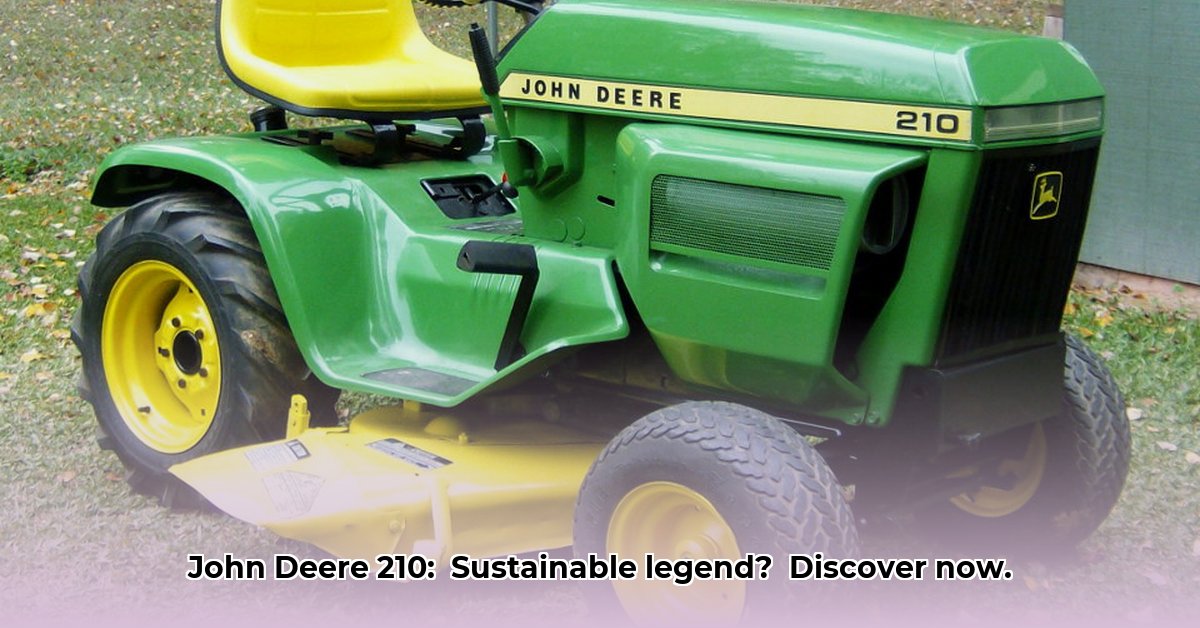
The John Deere 210: a name whispered with reverence by seasoned farmers and avid collectors alike. More than just a piece of agricultural machinery, this compact tractor, produced from 1975 to 1987, embodies a fascinating chapter in the evolution of sustainable farming practices. Its enduring legacy extends far beyond its twelve-year production run, prompting us to examine its surprising relevance in today's world. This article delves into the technical aspects, historical context, and enduring impact of this iconic machine. For more on older John Deere tractors, see this helpful resource: Older John Deere Tractors.
A Workhorse Built to Endure: The John Deere 210's Design and Longevity
Imagine a time before GPS guidance and advanced computer systems. The John Deere 210, a relatively small but remarkably robust tractor, was a ubiquitous sight across fields nationwide. Its impressive twelve-year production run isn't merely a testament to its reliable design; it’s a compelling case study in sustainable engineering. This longevity significantly reduces the environmental impact associated with frequent equipment replacements, minimizing waste and resource consumption. How did Deere achieve this remarkable durability? The answer lies in a combination of robust materials and a design philosophy prioritizing repairability over planned obsolescence.
Wasn't the reduced horsepower of the JD210 a drawback? While its 10-horsepower Kohler engine might seem modest by today's standards, its efficiency in the context of its time was notable. This relative fuel economy, coupled with the tractor’s extended lifespan, presents a compelling argument for the long-term sustainability of its design.
Built for Repair: A Circular Economy Approach
The John Deere 210's remarkable sustainability story extends beyond its sturdy construction. Unlike many contemporary products designed for planned obsolescence, this tractor was explicitly engineered for repair. Comprehensive service manuals and readily available parts remain accessible even today, facilitating prolonged use and significantly extending the machine's operational lifespan. This emphasis on repairability stands as a beacon in the modern pursuit of a circular economy, prioritizing reuse and minimizing landfill burden. The ease with which skilled mechanics could address mechanical issues further reduced reliance on new parts and further minimized the environmental impact.
How does the repairability of the JD210 compare to modern equipment? The stark contrast to many modern machines highlights the significance of design choices that prioritize longevity and repair.
Environmental Impact: A Nuanced Perspective
While the John Deere 210's inherent durability and repairability contribute significantly to its sustainability profile, it's crucial to acknowledge the limitations of its era. Emission standards and fuel efficiency metrics differed vastly from modern standards. Specific data on its fuel consumption remains somewhat scarce, hindering direct comparisons to contemporary tractors. Further research is necessary to fully quantify its historical environmental impact, encompassing factors like materials sourcing, manufacturing processes, and the long-term effects of its eventual disposal.
What specific data is missing to fully assess its environmental footprint? A comprehensive analysis necessitates detailed research into manufacturing processes, materials analysis, and complete lifecycle evaluations, accounting for embodied energy and disposal methods.
Actionable Insights: Preserving the Legacy
The John Deere 210's legacy extends beyond its historical significance. It provides invaluable lessons for various stakeholders:
Antique Tractor Enthusiasts: Restore and maintain existing John Deere 210s, meticulously documenting repair methods and creating a central online repository of parts and repair information. This collaborative effort preserves both the tractor's history and the knowledge associated with its maintenance.
Agricultural Historians: Analyze the tractor's design and manufacturing processes, comparing them to modern counterparts to illuminate advancements—or regressions—in sustainable agricultural machinery. Detailed studies can reveal crucial insights into evolving design philosophies and environmental priorities across different eras.
Modern Equipment Manufacturers: Analyze the JD 210’s robust design for insights into durability. Incorporate these principles into the design of new agricultural equipment, emphasizing longevity, repairability, and reduced environmental impact. This proactive approach can lead to significant long-term sustainability benefits.
Conclusion: A Timeless Lesson in Sustainability
The John Deere 210, though a product of a bygone era, offers invaluable lessons about sustainable design and the importance of building for longevity. While a comprehensive environmental assessment requires further research, its remarkable durability and repairability serve as a compelling example of building machines for lasting use, minimizing environmental impact throughout their full lifecycle. The story of the John Deere 210 is a testament to the enduring power of robust engineering and a valuable reminder of the importance of sustainability in agricultural technology. Its legacy continues to inspire innovation and shape the future of sustainable farming practices.